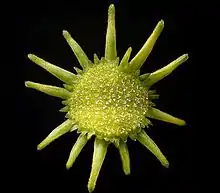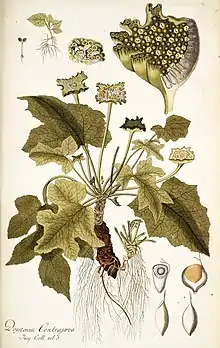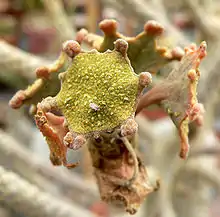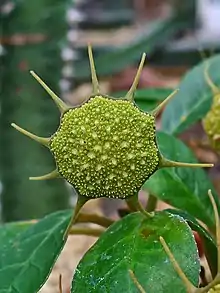Dorstenia
Dorstenia is a genus within the mulberry family, Moraceae. Depending on the author, there are said to be 100 to 170 species within this genus, second only in number to the genus Ficus within Moraceae. Dorstenia species are mainly known for their unusual inflorescences and growth habits. Dorstenia is named in honor of the German physician and botanist Theodor Dorsten (1492–1552).[1] The type species is Dorstenia contrajerva.
| Dorstenia | |
|---|---|
 | |
| Pseudanthium of Dorstenia hildebrandtii | |
| Scientific classification | |
| Kingdom: | Plantae |
| Clade: | Tracheophytes |
| Clade: | Angiosperms |
| Clade: | Eudicots |
| Clade: | Rosids |
| Order: | Rosales |
| Family: | Moraceae |
| Tribe: | Dorstenieae |
| Genus: | Dorstenia L. |

Growth habit
Dorstenia is unique in the family Moraceae because of the extremely diverse growth habits and forms of its species. While the majority of Moraceae are woody perennials, Dorstenia species are predominantly herbaceous, succulent, or suffrutescent perennials. Only 10% exhibit the typical woody habit of the Moraceae.[2]


The spectrum of the genus Dorstenia ranges from small annuals to perennial herbaceous plants with and without rhizomes or tubers, geophytes, lithophytes, epiphytes, woody shrubs and succulents (stem or leaf succulents). Their juice is mostly milky white, rarely yellow or colorless. The hairs that are found on most species are at least partially hook-shaped.
The leaves mostly are arranged in spirals and rosettes, and rarely as two-rowed leaves. The leaf blades may be shield-, hand- or foot-shaped, whole, incised, lobed or feathered. Usually the leaf edges are perforated or notched. The ever-present stipulae are also variable in shape. Usually they are leathery, sometimes large, leaf-like and durable or sometimes small, awl-shaped and quickly falling off.[2]
Reproductive structure and fruits
The most striking characteristic of Dorstenia is their reproductive structure, called pseudanthium (Greek for "false flower") or in Moraceae hypanthium, which is composed of clusters of tiny unisexual flowers on a disc- or cup-shaped receptacle that are often adorned with bracts of various sizes and shapes. The pseudanthiums can be planar, convex, concave, round, oval, square, lobed, twig, star, boot, or tongue-shaped. Their color varies from green to yellowish and reddish to violet and brown. Beneath the pseudanthium, there are usually bracts, scattered or in rows, sometimes carrying appendages. Sometimes the bracts are absent and only their remaining tooth-shaped, awl-like, spatula-shaped or band-shaped appendages are recognizable.

The globular, tapered, or warty flowers are unisexual. The female flowers within the receptacle mature first. The male flowers are either scattered between the female flowers or are concentrated on the outer edge of the receptacle or are separated by a flower-free zone at the outer edge. They are stalked and carry one to four (usually two to three) free or almost free tepals and one to four (usually two to three) stamens. The sunken female flowers carry tubular tepals and a free fruit node with one or two, then mostly unequal scars. The stone fruits are embedded in the broadened inflorescence axis and when mature are scattered by a centrifugal mechanism . Like most members of the Moraceae, Dorstenia species have drupe like fruits that are embedded in the receptable. However, a special feature of Dorstenia drupes is that they explode to release and scatter the seeds by way of a centrifugal mechanism. The stone seeds are usually small with a minuscule endosperm.[2]
Taxonomy
Dorstenia is part of the tribe Dorstenieae of the family Moraceae, and all three levels of classification are monophyletic from chloroplast and nuclear DNA phylogenies, with morphological characters that also support.[3] The family Moraceae is a part of the monophyletic order Rosales, and within this order Moraceae is most closely related to the plant families Ulmaceae, Cannabaceae, and Urticaceae.[4]

Evolution
Fossils of Ficus and Morus fruits have been found on the African continent, and are used to approximate the origin of family Moraceae to a maximum of 135 million years ago. In a recent study using fossil fruits, Bayesian molecular dating, and maximum likelihood, researchers attempted to reconstruct the ancestral history of Dorstenia with ITS (internal transcribed spacer) sequences from ribosomal DNA of 35 Dorstenia species and seven out-group species from the different tribes within the Moraceae. The goal was to resolve a long-standing issue within Dorstenia of if this genus diverged and radiated prior to the split of Africa and South American about 105 mya, and members of this genus are on separate continents by vicariance, or if this genus diverged post split and Dorstenia became established in the Neotropics by seed dispersal.[5]
This study produced an interesting phylogeny that revealed an initial old world divergence around 112.3 mya, divergence and radiance of new world Dorstenia at 67.2 and 30.3 mya respectively, and an old world group nested within the new world that radiated around 13.6 mya. The results of this phylogeny do not determine if vicariance or seed dispersal is the cause behind the old and new world populations of Dorstenia; however, it does pose several hypotheses regarding how the new world population came about as well as how three old world Dorstenia species are nested in the new world clade of the phylogeny. Due to the small endosperm that is typical of Dorstenia seeds, it is unlikely that seed dispersal by animals is the reason for the new world and reemerged old world species. However, it is possible that the new world population emerged by transport over the Beringia, established populations all throughout the North and South Americas, and when climate conditions changed and North America was no longer tropical or subtropical that the North American population died out, leaving only the New World population seen today in South America. This idea also allows for the Old World species nested within the new world by Dorstenia populations established in America returning to Africa by Beringia. For this hypothesis to receive more credence, fossil Dorstenia plants in North America would be needed.[5]
Distribution and habitat
The species are fairly equally distributed between the Afrotropics and Neotropics. Only one species grows east of Arabia, in the tropical forests of Southern India and Sri Lanka.
Uses
South American species such as Dorstenia contrajerva and Dorstenia brasiliensis[6] are a source of the herbal preparation contrayerva that has been used as a tonic and febrifuge, and as an antidote in South American folk medicine.[6][7] In North America powder made from the rootstocks and leaves of Dorstenia contrajerva is mixed with tobacco for improving the taste of cigarettes.[8] In Oman the tubers of Dorstenia foetida are cooked and eaten.[9] Dorstenia barteri is used in West African folk medicine. Scientific research has shown that it contains numerous flavonoid compounds that have anti-microbial, anti-reverse transcriptase, and anti-inflammatory effects.[10][11]
Species
In the past many species were described that are now considered synonyms. This is due to the great variability of many Dorstenia species. New species are still discovered, such as Dorstenia luamensis a hanging lithophyte from Congo, first described in 2014.[12] The following list only contains the accepted species (without varieties) as listed in The Plant List.[13]
- Dorstenia africana
- Dorstenia afromontana
- Dorstenia albertii
- Dorstenia alta
- Dorstenia angusticornis
- Dorstenia annua
- Dorstenia appendiculata
- Dorstenia arifolia
- Dorstenia aristeguietae
- Dorstenia africana
- Dorstenia astyanactis
- Dorstenia bahiensis
- Dorstenia barnimiana
- Dorstenia barteri
- Dorstenia belizensis
- Dorstenia benguellensis
- Dorstenia bergiana
- Dorstenia bicaudata
- Dorstenia bonijesu
- Dorstenia bowmanniana
- Dorstenia brasiliensis
- Dorstenia brevipetiolata
- Dorstenia brownii
- Dorstenia buchananii
- Dorstenia caatingae
- Dorstenia caimitensis
- Dorstenia carautae
- Dorstenia cayapia
- Dorstenia ciliata
- Dorstenia choconiana
- Dorstenia colombiana
- Dorstenia conceptionis
- Dorstenia contensis
- Dorstenia contrajerva
- Dorstenia convexa
- Dorstenia crenulata
- Dorstenia cuspidata
- Dorstenia dinklagei
- Dorstenia dionga
- Dorstenia djettii
- Dorstenia dorstenioides
- Dorstenia drakena
- Dorstenia elata
- Dorstenia ellenbeckiana
- Dorstenia elliptica
- Dorstenia embergeri
- Dorstenia erythrantha
- Dorstenia excentrica
- Dorstenia fawcettii
- Dorstenia flagellifera
- Dorstenia foetida
- Dorstenia gigas
- Dorstenia goetzei
- Dorstenia grazielae
- Dorstenia gypsophila
- Dorstenia hildebrandtii
- Dorstenia hildegardis
- Dorstenia hirta
- Dorstenia holstii
- Dorstenia indica
- Dorstenia involuta
- Dorstenia jamaicensis
- Dorstenia kameruniana
- Dorstenia lanei
- Dorstenia lavrani
- Dorstenia le-testui
- Dorstenia lindeniana
- Dorstenia lujae
- Dorstenia mannii
- Dorstenia mariae
- Dorstenia milaneziana
- Dorstenia nummularia
- Dorstenia nyungwensis
- Dorstenia oligogyna
- Dorstenia panamensis
- Dorstenia paucibracteata
- Dorstenia peltata
- Dorstenia peruviana
- Dorstenia petraea
- Dorstenia picta
- Dorstenia poinsettiifolia
- Dorstenia prorepens
- Dorstenia psilurus
- Dorstenia ramosa
- Dorstenia renulata
- Dorstenia richardii
- Dorstenia rocana
- Dorstenia roigii
- Dorstenia scaphigera
- Dorstenia schliebenii
- Dorstenia setosa
- Dorstenia socotrana
- Dorstenia soerensenii
- Dorstenia solheidii
- Dorstenia subdentata
- Dorstenia subrhombiformis
- Dorstenia tayloriana
- Dorstenia tenera
- Dorstenia tentaculata
- Dorstenia tenuiradiata
- Dorstenia tenuis
- Dorstenia tessmannii
- Dorstenia thikaensis
- Dorstenia tuberosa
- Dorstenia turbinata
- Dorstenia turnerifolia
- Dorstenia ulugurensis
- Dorstenia umbricola
- Dorstenia urceolata
- Dorstenia uxpanapana
- Dorstenia variifolia
- Dorstenia vivipara
- Dorstenia warneckei
- Dorstenia yambuyaensis
- Dorstenia yangambiensis
- Dorstenia zambesiaca
- Dorstenia zanzibarica
- Dorstenia zenkeri
References
- Genaust, Helmut (1976). Etymologisches Wörterbuch der botanischen Pflanzennamen ISBN 3-7643-0755-2
- Berg, Cornelis C. (2001). "Moreae, Artocarpeae, and Dorstenia (Moraceae), with Introductions to the Family and Ficus and with Additions and Corrections to Flora Neotropica Monograph 7". Flora Neotropica. 83: 1–346.
- Clement, Wendy L.; Weiblen, George D. (2009). "Morphological Evolution in the Mulberry Family (Moraceae)". Systematic Botany. 34 (3): 530–552. doi:10.1600/036364409789271155. ISSN 0363-6445. S2CID 85680800.
- Zhang, Shu-dong; Soltis, Douglas E.; Yang, Yang; Li, De-zhu; Yi, Ting-shuang (2011). "Multi-gene analysis provides a well-supported phylogeny of Rosales". Molecular Phylogenetics and Evolution. 60 (1): 21–28. doi:10.1016/j.ympev.2011.04.008. ISSN 1055-7903. PMID 21540119.
- Misiewicz, T. M.; Zerega, N. C. (2012). "Phylogeny, Biogeography and Character Evolution of Dorstenia (Moraceae)". Edinburgh Journal of Botany. 69 (3): 413–440. doi:10.1017/S096042861200025X. ISSN 0960-4286.
- "Contrayerva". Oxford English Dictionary (Online ed.). Oxford University Press. (Subscription or participating institution membership required.)
- Grieve, M. “Contrayerva”, A Modern Herbal. Retrieved on 14.10.2017.
- Mansfeld's Database of Agricultural and Horticultural Plants. Retrieved 14.10.2017.
- Cactus Art Nursery. “Dorstenia sp. ( foetida form)”. Retrieved 14.10.2017.
- Kuete, V.; Ngameni, B.; Mbaveng, A.T.; Ngadjui, B.; Meyer, J.J. Marion; Lall, N. (2010). "Evaluation of flavonoids from Dorstenia barteri for their antimycobacterial, antigonorrheal and anti-reverse transcriptase activities". Acta Tropica. 116 (1): 100–104. doi:10.1016/j.actatropica.2010.06.005. ISSN 0001-706X. PMID 20599632.
- Omisore, N.O.A.; Adewunmi, C.O.; Iwalewa, E.O.; Ngadjui, B.T.; Watchueng, J.; Abegaz, B.M.; Ojewole, J.A.O. (2004). "Antinociceptive and anti-inflammatory effects of Dorstenia barteri (Moraceae) leaf and twig extracts in mice". Journal of Ethnopharmacology. 95 (1): 7–12. doi:10.1016/j.jep.2004.05.022. ISSN 0378-8741. PMID 15374600.
- Leal, M. (2014). "Dorstenia luamensis (Moraceae), a new species from eastern Democratic Republic of Congo". PhytoKeys. 42 (42): 49–55. doi:10.3897/phytokeys.42.7604. PMC 4225074. PMID 25383011.
- The Plant List. Retrieved 24.10.2017.
External links
| Wikispecies has information related to Dorstenia. |
| Wikimedia Commons has media related to Dorstenia. |
